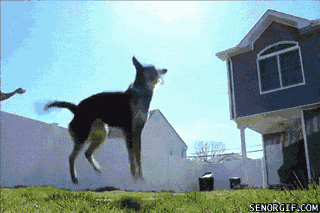#1. "American Bully has a short, close, stiff to the touch, and glossy coat. All colors and patterns are acceptable."
#2. "The head of the American Bully is a medium length, deep through, broad skull, very pronounced cheek muscles, distinct stop, and high set ears."
#3. "The ears can be cropped or uncropped."
#4. "Eyes - All colors except albinism. Round to oval, low down in skull and set far apart."
#5. "Jaws well defined. Under jaw to be strong and display biting power. Lips close and even, some looseness accepted, but not preferred. Upper teeth to meet tightly outside lower teeth in front or scissor bite accepted."
#6. "Nose all colors acceptable."
#7. "The neck is heavy, slightly arched, tapering from shoulders to back of skull."
#8. "No looseness of skin."
#9. "Medium length."
#10. "Shoulders are strong and muscular with blades wide and sloping."
#11. "The back is fairly short."
#12. "The body has well-sprung ribs, deep in rear. All ribs close together."
#13. "Forelegs set rather wide apart to permit chest development."
#14. "Chest deep and broad."
#15. "The tail is short in comparison to size, low set, tapering to a fine point; not curled. Not docked."
#16. "Front legs should be straight. A slight turning outwards of the feet is accepted but not desired, large or round bones, pastern upright."
#17. "No resemblance of bend in front."
#18. "Hindquarters- well-muscled, let down at hocks, turning neither in nor out."
#19. "Feet- of moderate size, well-arched and compact."
#20. "The American Bully is a happy, outgoing, stable, and confident dog."
#21. "Gentle and loving towards people."
#22. "Good-natured, amusing, extremely loyal and affectionate family pet."
#23. "Almost always obedient, this dog wants nothing more then to please its master."
#24. "It is an extremely courageous and intelligent guard dog that is very full of life."
#26. "This unique breed is noted for displaying extreme tolerance with children and an overwhelming eagerness to please its family."
#27. "Confident, yet not aggressive, this breed possesses a very pleasant temperament."
#28. "Physically, the American Bully has an impressive, athletic build, which is both muscular and defined, and displays strength and agility."
#29. "The breed is versatile and capable of accomplishing a wide variety of tasks."
#30. "All around, the American Bully is a well rounded, reliable, trustworthy, and ideal family companion."
#31. "The breed is very outgoing with an eagerness to please."
#32. "They are known for their courage."
#33. "Courageous and a persistent fighter if provoked."
#34. "Highly protective of its owners and the owner's property, it will fight an enemy to the death if the enemy traps the dog in a corner and threatens its loved ones."
#35. "This breed has a very high tolerance for pain."
#36. "Socialize very thoroughly when young to curve any dog aggressive tendencies."
#37. "It has given outstanding results as a guardian of property, but is at the same time esteemed as a companion dog."
#38. "This breed is not for the passive owner who does not understand that all dogs have an instinct to have a pack order. Read Top Dog. The American Bully needs an owner who is firm, but calm, confident and consistent. They need to know what is expected of them; rules to follow and limits to what they are and are not allowed to do. The objective in training and successfully keeping this dog is to achieve a pack leader status. It is a natural instinct for a dog to have an order in their pack. When we humans live with dogs, we become their pack. The entire pack cooperates under a single leader. Lines are clearly defined. You and all other humans MUST be higher up in the order than the dog. That is the only way your relationship can be a success."
#39. "Height: Males 18 - 21 inches (46-53 cm)
Females 17 - 20 inches (43-51 cm.)"
#40. "There is no particular weight for the breed."
#41. "American Bullys will do okay in an apartment if it is sufficiently exercised. They are very active indoors and will do alright without a yard provided they get enough exercise. Prefers warm climates."
#42. "American Bullys must have plenty of regular exercise including a long brisk daily pack walk to relieve mental and physical energy."
#43. "The smooth, short-haired coat is easy to groom. Brush on a regular basis with a firm bristle brush, and bathe or dry shampoo as necessary. A rub with a piece of toweling or chamois will make the coat gleam. This breed is an average shedder."
#44. "The American Bully breed was established in the mid 1990 s with the purpose of creating the ultimate family companion. The American Bully was created through years of selective breeding by combining the desired traits of the UKC American Pit Bull Terrier and the AKC American Staffordshire Terrier. The American Bully's origin's can be seen both on the East and West Coast of the United States, primarily in Virgina, and Los Angeles, California. Today the American Bully can also be seen, in Europe and Asia."
Info and pics from: http://www.dogbreedinfo.com/a/americanbully.htm






























